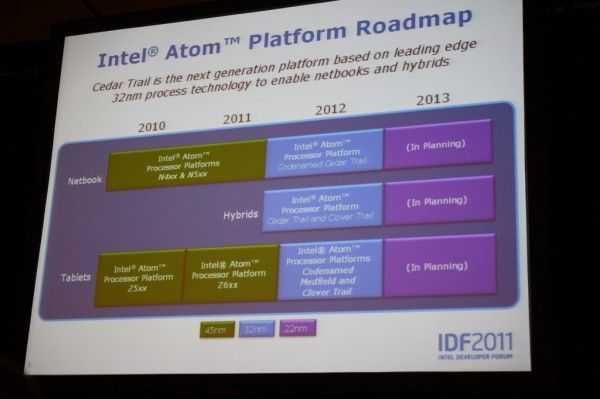Today at IDF 2011, Intel held a session that was all about Android Honeycomb on Atom. We came away with a good bit of info about how Android on Intel will compare to Android on ARM, and how Intel plans on differentiating its products.
The beginning of Android on Intel happens on the Medfield platform, which utilizes a 32nm manufacturing process. In 2013, Intel plans to move to 22nm, and in 2014 14nm.
The smaller the manufacturing process, the more transistors can be printed on a single CPU wafer which makes the process more cost effective (making the cost of CPUs cheaper. Smaller transistors also means being able to compact the CPU design allowing room for more features (graphics, caches, etc.).
Medfield devices will be the first x86 Honeycomb devices that are consume available, and Intel expects to see this happen in Q1 2012. According to Intel, their archiecture has no disadvantages over ARM when it comes to battery life on size of a potential tablet product. According to them, battery life and screen thickness become the limiting factors. No size and battery life disadvantages, sure, but it reamins to be seen if they can achieve the same performance:power consumption ratio that ARM currently has (if not better).
To differentiate (ie: make their product more appealing than ARM-based devices), Intel is touting gains in performance, video imaging, and WiDi (wireless display).
Performance isn’t something we cast test very well before Android is fully optimized for Intel’s architecture, but WiDi is certainly a feature that will make Android + Intel stand out.
WiDi allows wireless video output from a device to a box hooked up to a TV or monitor. We’ve seen WiDi in action here at IDF outputting up to 1080p video (from a desktop to an STB — MiDi on Medfield may be lower res-capable) and this is something that no ARM tablet does today.
Video imaging is another place where Medfield tablets hope to stand out. Intel says that there is support for 1080p encoding (which means not only the ability to record at 1080p but also the ability to create content effectively at that resolution [ie: video rendering]). A number of ARM tablets today have 1080p output support, but not record capabilities.
Intel also shared some basic info out their Medfield Honeycomb reference design which they call Red Ridge: 1280×800, 10.1 inch screen, 8.9mm thick, under 700gm, Micro USB and micro HDMI.
For developers, an NDK (native development kit) with x86 support is available on the Android developer website today. Intel plans on having an x86 Honeycomb emulator available from the Android developer website in Q4 of 2011.












Ok, so what happened to meego?
Intel claims that they’re still supporting it, but is now saying that Android is their ‘[mobile] OS of choice’. They fall back by saying that they have a multi-OS strategy just like any other company. It’s unclear where its headed, but it seems like a lot of people still find it useful as a Linux-based starting point for a broad range of applications.
I was hoping the WiDi works reversed, that the tablet can be the WiDi reciever, ie. acts as a convenient and low-powered touchscreen to an ultra-book or monitorless ultrabook module.
Is there any hope we could see that soon?
That would be pretty awesome. I think there are a few apps that do this sort of thing in the Android market already (I know the iPad has some), at least from a screen-extender point of view. Good idea, I hope it can be two-way, but I’m not sure.